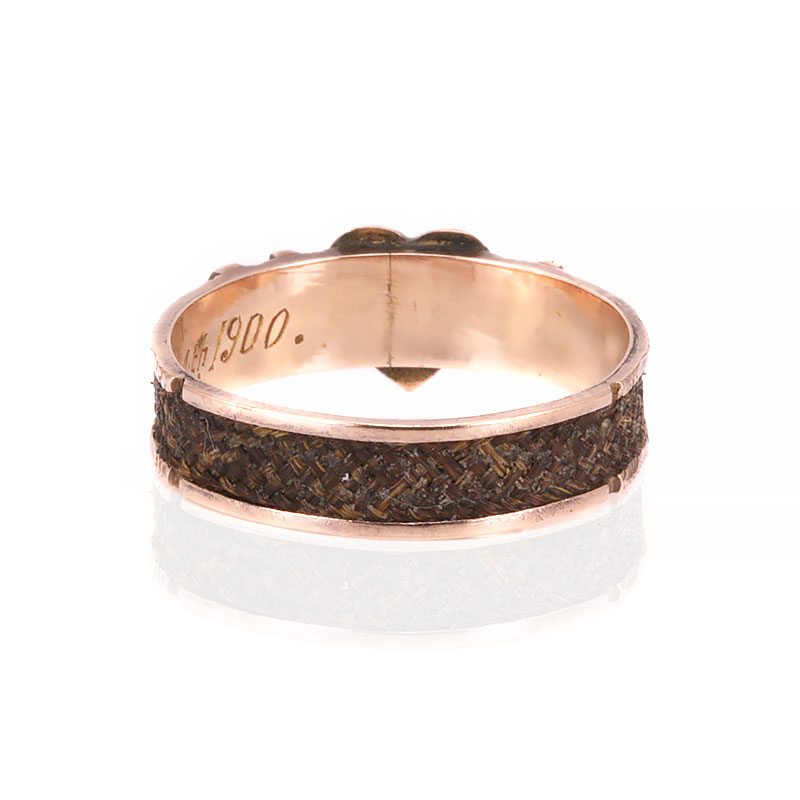
This mourning ring is the next item in our Kalmar Vault series and from this ring we begin to understand Christian iconography and mourning rituals prevalent at the turn of the 20th century. Pieces such as this one offers us a unique portal into history and to those who came before us. The inscription of this piece reads “Dad died 4th of March 1900" on the inside of the band with the initials inscribed upon the heart at the front of the piece. The intention of this piece is clear in its purpose to serve as a memento of a Father by his family.
To understand the layer of emotion entwined with this mourning ring we must first understand the context of the symbolism chosen to adorn the front of this piece. The front of the ring features the three symbols of Christian virtue including the cross, anchor and heart. These symbols displayed in unison represent faith, hope and charity and have become a common allegory used in jewellery design.

Cathedral dome mural personifying faith, hope and charity. Source: Marywood University
It is important to note that in this context the term charity is interchangeable with the word love. Charity in Christian thought signifies the highest form of love, an unselfish love of ones fellow man based on the reciprocal love between man and God (Britannica, 2022). The mention of these virtues can be found in the Christian writings of St. Paul who, in a letter to the church at Thessalonian as they faced persecution, stated “we remember before our God and Father your work produced by faith, your labor prompted by love, and your endurance inspired by hope in our Lord Jesus Christ" (1 Thessalonians 1:3). The symbolism that would come to represent these virtues was later produced through various art practices with slight changes to the iconography over time.

The heart allegory, signifying charity, was originally depicted as a woman with small children around her but was later adapted to the heart shape in artworks from the late 14th century (Navette Jewellery, 2021). The anchor symbol to represent hope can be traced back to the New Testament Book of Hebrews in the passage “have this hope as an anchor for the soul, firm and secure" (Hebrews 6:18. 19). The anchor as a symbol of hope gained further relevance during the Napoleonic Wars when many men were seafaring and was interpreted as a symbol of hopes of a safe return (Erica Weiner, 2021). The cross is a more obvious signifier of the Christian faith that is still widely used today. We see these three symbols frequently portrayed together across art practices such as tapestry, painting and sculptures in the 17th century. The three virtues can be seen in jewellery design as early as the Georgian era but gained wide popularity in jewellery design from the late 18th century.
The incorporation of the three virtues in this mourning ring can be seen as a direct link to the deceased and their Christian faith. “Theology is one of the primary reasons for the creation of mourning and sentimental jewels, being a key identifier in someone's understanding of the afterlife and their relationship virtues" (Peters, 2022). Therefore, the inclusion of these symbols was a purposeful choice by the person who commissioned the mourning ring, whether that be the family or the deceased person themselves prior to their passing.

The other element of this ring is the hair work detail that is woven around the band. The inclusion of hair in jewellery was common from the Georgian era onwards as sentimental tokens of love and friendship as well as for commemorative purposes. In this particular ring the hair is included as a personal relic from the deceased and has been included as a memento.
The gifting of mourning rings at funerals had become common practice throughout the Victorian era but was particularly prevalent after the death of Prince Albert when Queen Victoria plunged England into an era of high mourning. The influence of the grieving monarch over her nation kick started an industry designed to meet the needs of these strict societal protocols. Standards of dress were to be adhered to after the loss of a loved one and the distribution of mourning rings at funerals was seen as a comment on the class and status of the family. These mourning practices spread across the United States as well as Britain as the Civil War left many grieving families in its wake. Australia was also adhering to these practices with its direct influence as a Commonwealth Nation of Britain. “That people could afford these jewels is even more remarkable, given that producing bespoke rings in volume was not as easy a task as it was in the 19th century, following the use lower grade alloys and machinery development during the Industrial Revolution" (Peters, 2022). The time which this ring was produced was at the turn of the century when societal attitudes were shifting after decades of adhering to the Queen's strict mourning protocols. Mourning practices were on the decline but mourning jewellery was still being mass produced and gifted to loved ones.

This ring gives us insight into the mourning rituals and customs of the Western world during the 19th century to the early 20th century. It provides us with a tangible connection to the deceased and their theological beliefs. These pieces of jewellery were created with the intention that their loved one would be remembered. It is an amazing thought that these pieces have lasted the test of time and that these items and the memory of those which they commemorate endure.
Sources:
Britannica (2022), 'Charity Christian concept', Britannica; https://www.britannica.com/topic/charity-Christian-concept
Erica Weiner (2022), 'Diamond and pearl faith, hope and charity ring', Erica Weiner; https://ericaweiner.com/products/late-victorian-diamond-and-pearl-faith-hope-charity-ring
Navette Jewellery (2021), 'Symbolism in antique jewellery - faith, hope and charity (love)', Navette Jewellery; https://navettejewellery.org/2021/07/07/symbolism-in-antique-jewellery-faith-hope-and-charity-love/
Peters, Hayden (2022), 'Colonial Australian sentimental jewels', Art of Mourning; https://artofmourning.com/colonial-australian-sentimental-jewels/
Peters, Hayden (2022), 'Faith, hope and charity', Art of Mourning; https://artofmourning.com/faith-hope-and-charity/






